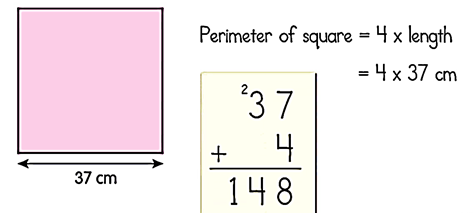Imagine you are given a piece of a picnic cloth
and the teacher is asking you how much ribbon needs to be used to decorate
around the cloth. It is a group task with each group getting a cloth that are either rectangular or squared and the teacher is only going to provide as much ribbon as you ask for. So, how can you tell the exact measure of ribbon needed?
Now as you learned in early grades, this is pretty simple.
You find the PERIMETER of the cloth.
What is Perimeter?
The word comes from two Greek words; peri, meaning 'around', and metron, meaning 'measure'. So perimeter is the distance or measure around something. Unit is cm, m, km as measured in length.
Calculating Perimeter
Now let's take the image of a rectangular cloth below as an example for one of the picnic cloths given by the teacher.
When we take the distance around the cloth, it will be somewhat like the image on the right, which is why the formula for Perimeter of rectangle is:
P = 2 (length + breadth/width)
The groups which received the square cloth like the one below, will use the formula below to find how much ribbon they need:
P = 4 x length
Now let's say the square has a length of 37m on each side. By applying the formula the total perimeter of the square would be 148cm, which is how much ribbon they need for decoration.
Moving on with the lesson, the teacher wanted to find out which group received the biggest cloth. Now, how do we find that?
As you may already be familiar, to find the biggest cloth we need to know the surface taken up by each cloth, which is also known as the AREA of a shape.
What is Area?
The word 'Area' means a vacant piece of ground in Latin. In Mathematics, it is defined as the total space occupied by a flat 2D shape of an object. It is the number of unit squares occupied by the surface of a closed figure, which is why is is measured in square units. (cm2, m2, km2)
Calculating Area
(Area = length x breadth, Area = 4 x 3, which is
It's time to see the real life applications of perimeter and Area.
Watch the presentation below to see real life applications of perimeter and area:










Thank you :)
ReplyDeletevery easy to understand
ReplyDelete